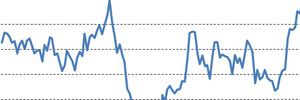 Confidence among construction firms has reached a nine-year high despite rising costs and uncertainty about the General Election stunting overall output in the sector to its lowest point in three months.
Confidence among construction firms has reached a nine-year high despite rising costs and uncertainty about the General Election stunting overall output in the sector to its lowest point in three months.
According to the latest construction survey from Markit and the Chartered Institute of Procurement & Supply (CIPS), the PMI for March dropped to 57.8 from the previous month’s 60.1. While it remains above the 50 mark dividing contraction and growth, the reading was well below the expected figure of 59.8. The latest reading was also well below the average PMI of 61.8 for 2014 as a whole.
All three broad categories of construction saw further declines in momentum since February. Housing remained the strongest of the three, with commercial sector activity beginning to catch up while civil engineering eased markedly.
David Noble, group chief executive officer CIPS, said:
“The construction sector’s strong recovery took on a gentler, quieter pace, with the housing sector continuing to lead the way ahead – but only just, and with the commercial sector a close second.”
Tim Moore, senior economist at Markit and author of the Markit / CIPS Construction PMI, agreed with Mr. Noble’s conclusion and claimed that
“the recovery has lost some of its swagger since last year.”
Some firms have claimed that the ongoing period of declining activity is related to uncertainty surrounding May’s General Election, which has encouraged clients to delay spending decisions. This caution has also reportedly led to the least marked increase in overall employment figures since December 2013.
Despite these concerns, new business volumes continued to rise throughout March, which some companies claimed was a consequence of improving economic conditions and greater underlying client demand.
This has been supported by a recent publication from Glenigan, which pointed to a renewed surge in projects receiving detailed planning approval. During the first two months of 2015, approvals were up by 36% compared to a year earlier, with a marked 54% expansion in non-residential approvals.
Allan Wil‚n, economics director at Glenigan, said:
“However this replenishing bank of prospective projects with detailed permissions bodes well for growth during the second half of this year, especially if a credible Government emerges quickly from the aftermath of the election.”
The improving order books and a sustained increase in new tender opportunities has created a marked upturn in business confidence. More than half of those asked (57%) expect a rise in output over the next year, with only 3% forecasting a fall. This translates to the strongest degree of construction sector optimism in almost ten years.
Mr. Noble said:
“The main takeaway from this month must be the highest levels of confidence seen in the construction sector for almost a decade. Though there may be some low-level obstacles still to come, the sector gets the green light as there is evidently belief that the future for the construction sector is a sustainable one.”
The survey also found that sub-contractor availability has continued to fall, which in turn contributed to the steepest increase in sub-contractor charges since the survey began in April 1997.
Anecdotal evidence also suggested that stock shortages at suppliers, combined with demand for construction mate




